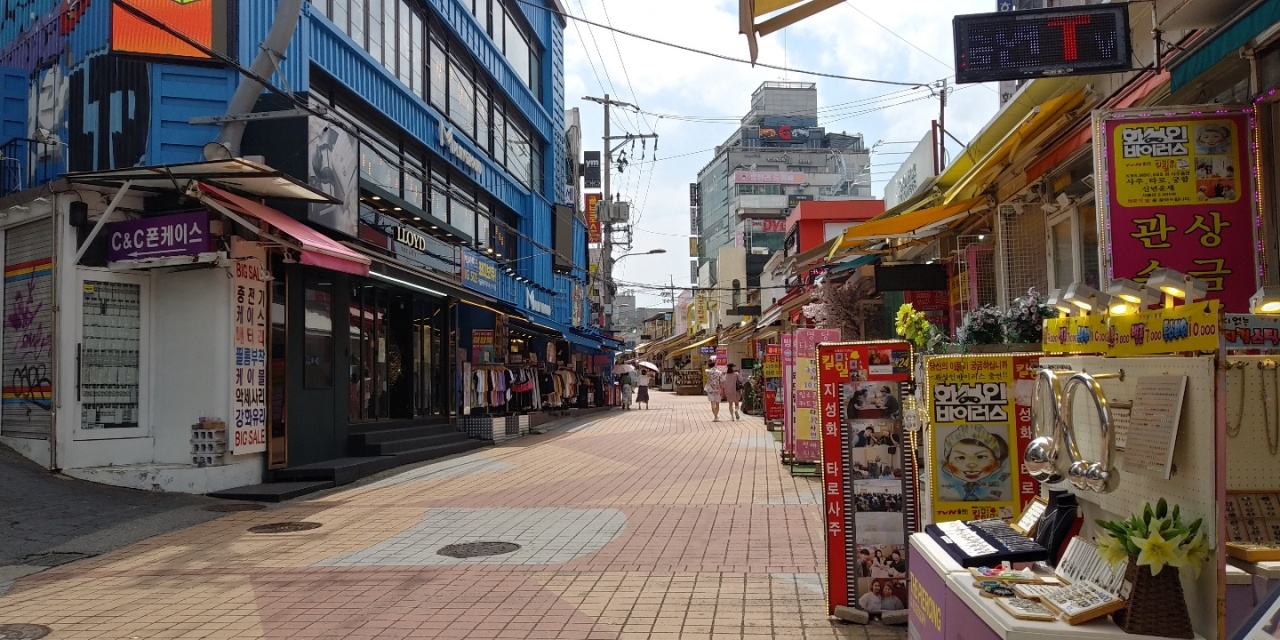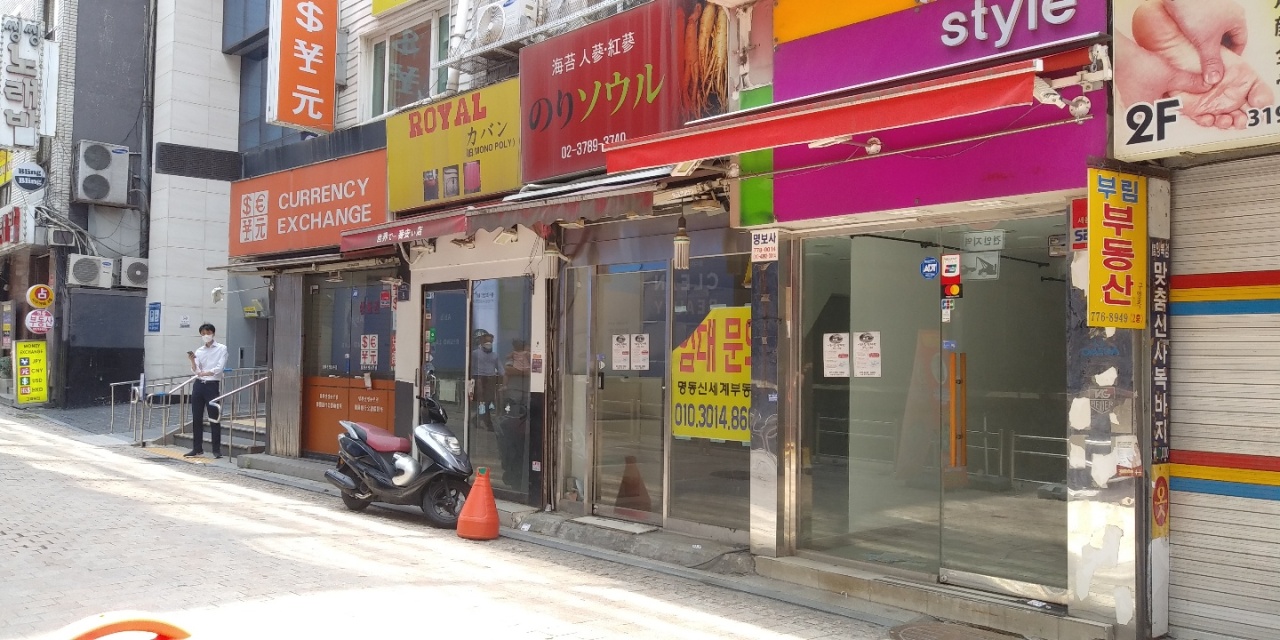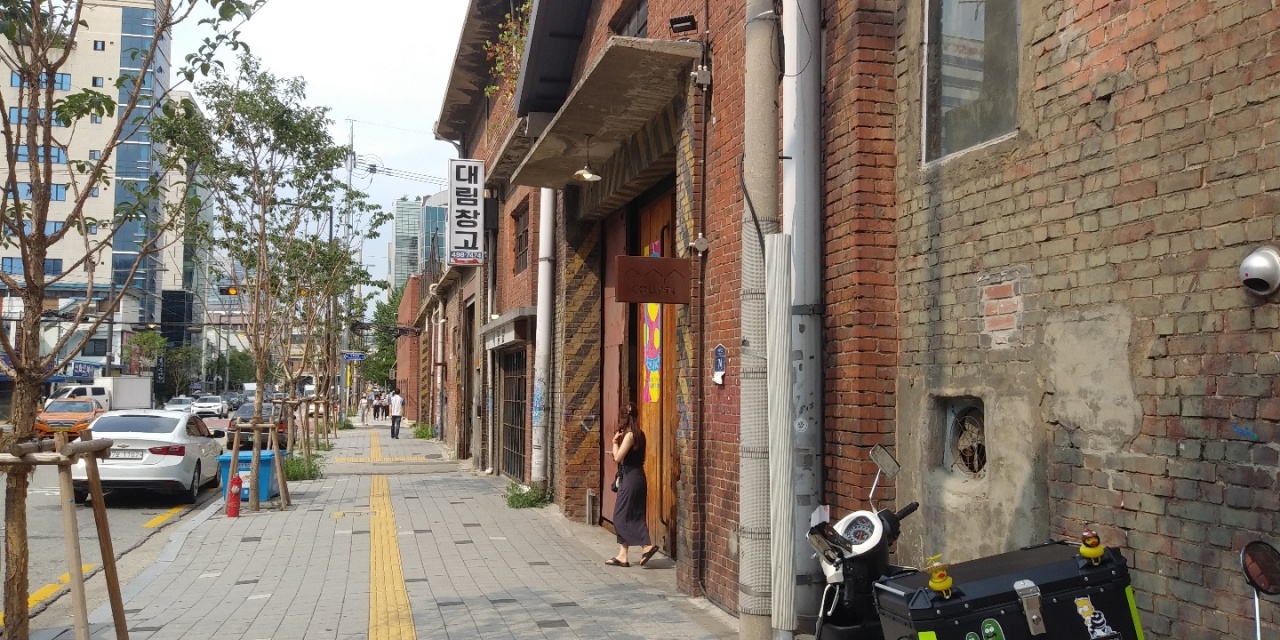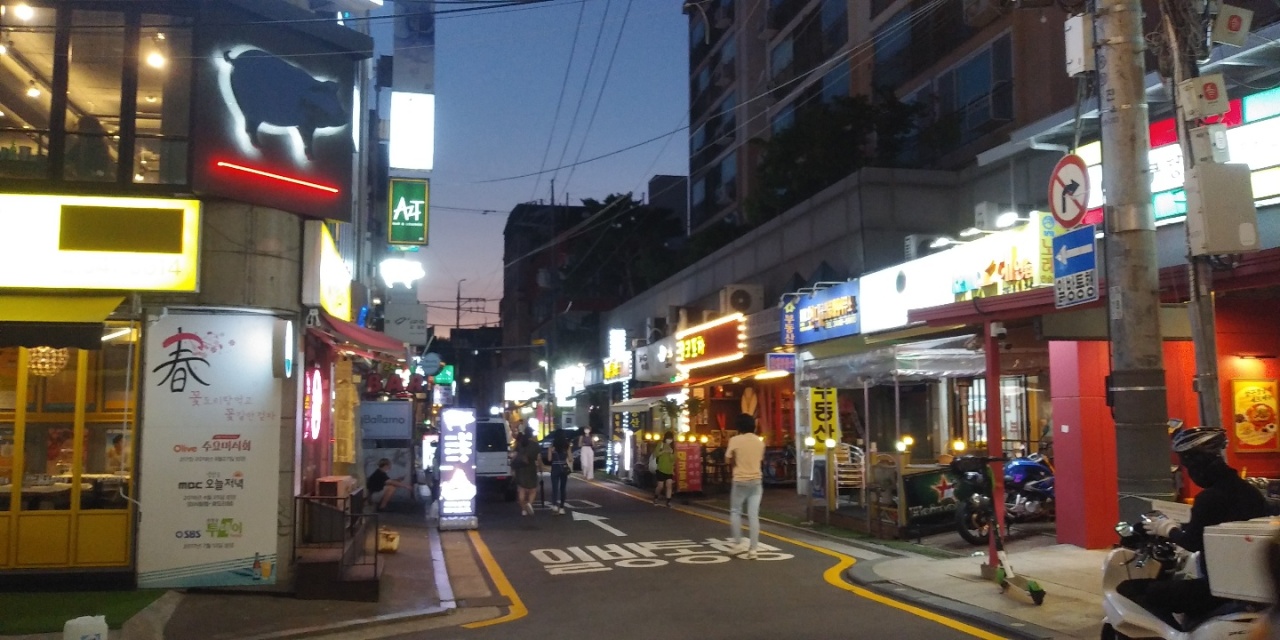[Anniversary Special] Pandemic forces small businesses to scramble for new strategies, new neighborhoods
Fear of virus, restrictive social distancing rules drive new consumer trends and new preferences for gatherings
By Ko Jun-taePublished : Aug. 14, 2021 - 16:00

As COVID-19 sweeps through society, once populous urban areas and tourist spots have become almost desolate, pushing small-business owners to the brink.
The strict social distancing rules are taking a heavy toll on small businesses, which was evident from what The Korea Herald saw last week in some of the most well-known areas in Seoul for social gatherings and entertainment.
On any given day of the week, the streets of Hongdae, western Seoul, are expected to be filled with people. The go-to college neighborhood in the area, known as a hub for music lovers and trendy shoppers, has always been a destination for people to grab lunch, dinner or drinks.
But under Level 4 social distancing rules, the hustle and bustle associated with the area is nowhere to be seen. Shops were open, but only the owners were inside, staring out the windows, on the lookout for potential customers.
The shops looked fine when viewed from a distance, with music flowing out of the doors and items on display and ready to be sold. But on a closer look, it was clear that most of the businesses were far from being all right.
Cooks at some restaurants were chatting among themselves empty-handed, while waiters were staring at their smartphones. They didn’t seem to expect any customers to walk in at 12:30 p.m.
Clothes displayed outdoors were only greeted with hot, steamy wind every now and then, and no customers were there to check them out or try anything on. Even the usual bands of pigeons weren’t easy to find as the temperature surpassed 32 degrees Celsius.
“Just get out,” shrieked a clothing shop owner when The Korea Herald attempted to ask questions about how her business had done in recent days.
“I haven’t seen any customers in days, and now a journalist comes in to ask me how miserable I am? I don’t need any more signs of bad luck. Just leave.”
The strict social distancing rules are taking a heavy toll on small businesses, which was evident from what The Korea Herald saw last week in some of the most well-known areas in Seoul for social gatherings and entertainment.
On any given day of the week, the streets of Hongdae, western Seoul, are expected to be filled with people. The go-to college neighborhood in the area, known as a hub for music lovers and trendy shoppers, has always been a destination for people to grab lunch, dinner or drinks.
But under Level 4 social distancing rules, the hustle and bustle associated with the area is nowhere to be seen. Shops were open, but only the owners were inside, staring out the windows, on the lookout for potential customers.
The shops looked fine when viewed from a distance, with music flowing out of the doors and items on display and ready to be sold. But on a closer look, it was clear that most of the businesses were far from being all right.
Cooks at some restaurants were chatting among themselves empty-handed, while waiters were staring at their smartphones. They didn’t seem to expect any customers to walk in at 12:30 p.m.
Clothes displayed outdoors were only greeted with hot, steamy wind every now and then, and no customers were there to check them out or try anything on. Even the usual bands of pigeons weren’t easy to find as the temperature surpassed 32 degrees Celsius.
“Just get out,” shrieked a clothing shop owner when The Korea Herald attempted to ask questions about how her business had done in recent days.
“I haven’t seen any customers in days, and now a journalist comes in to ask me how miserable I am? I don’t need any more signs of bad luck. Just leave.”

The situation was much worse in central Seoul’s Myeong-dong, which had lost most of its touristy vibe and consumer base with the COVID-19 pandemic limiting international travel.
A shoe store clerk had a thick stack of leaflets in her hands, but simply not enough people were in the area to take them. The clerk said she had been out there since 10 a.m. but had only handed out a little more than a dozen leaflets in three hours.
“It has already been reported in the media hundreds of times that Myeong-dong is dead, and I know I shouldn’t expect people to take these leaflets, but this is still part of my job, so I’m out here in deadly heat,” she said. “Just take a stroll around the block, and you will know what I mean.”
The Korea Herald visited every corner of Myeong-dong to find that a large number of shops with Chinese, English or Japanese signs were vacant, their owners having left behind only piles of trash and signs looking for new tenants.
Restaurants and bars catering to office workers have managed to survive, but empty seats were everywhere at 1:30 p.m., when shops would normally still have been serving lunchtime customers. Myeong-dong has even lost its iconic tour guides, dressed in red hats and vests, who walk around providing help to anyone who needs it.
Yet changes are in the works as small businesses promote new strategies to keep their heads above water.
Businesses have armed themselves to serve a wider range of customers. And they believe their lives can be better once social distancing rules are relaxed and the government passes more financial and policy support measures.
Some restaurants in Hongdae posted signs saying they now provide single-serving menu options and also deliver. A Korean barbecue joint offered to sell a combo of kimchi stew and pork belly for lunch, and bars offered to deliver drinks and snacks through smartphone applications.
“We know this situation is not going to end anytime soon, so we are trying to find ways to live with it,” said a manager of a Korean barbecue restaurant in Myeong-dong, which now offers a new menu for those coming alone.
“This is not perfect but we have seen some success in doing this. We are now serving more nearby office workers than tourists, which could be our new base of business.”
Accessory shops had fliers up to let customers know that certain lines of products were now available for purchase online. Some were promoting aggressive sales -- one clothing shop in the Hongdae area was providing discounts as high as 70 percent.
More importantly, experts point out, consumers have flocked to fairly unexplored areas for social gatherings, primarily within residential areas coupled with easy public transportation access and trendy offerings of vibrant restaurants and cafes.
A shoe store clerk had a thick stack of leaflets in her hands, but simply not enough people were in the area to take them. The clerk said she had been out there since 10 a.m. but had only handed out a little more than a dozen leaflets in three hours.
“It has already been reported in the media hundreds of times that Myeong-dong is dead, and I know I shouldn’t expect people to take these leaflets, but this is still part of my job, so I’m out here in deadly heat,” she said. “Just take a stroll around the block, and you will know what I mean.”
The Korea Herald visited every corner of Myeong-dong to find that a large number of shops with Chinese, English or Japanese signs were vacant, their owners having left behind only piles of trash and signs looking for new tenants.
Restaurants and bars catering to office workers have managed to survive, but empty seats were everywhere at 1:30 p.m., when shops would normally still have been serving lunchtime customers. Myeong-dong has even lost its iconic tour guides, dressed in red hats and vests, who walk around providing help to anyone who needs it.
Yet changes are in the works as small businesses promote new strategies to keep their heads above water.
Businesses have armed themselves to serve a wider range of customers. And they believe their lives can be better once social distancing rules are relaxed and the government passes more financial and policy support measures.
Some restaurants in Hongdae posted signs saying they now provide single-serving menu options and also deliver. A Korean barbecue joint offered to sell a combo of kimchi stew and pork belly for lunch, and bars offered to deliver drinks and snacks through smartphone applications.
“We know this situation is not going to end anytime soon, so we are trying to find ways to live with it,” said a manager of a Korean barbecue restaurant in Myeong-dong, which now offers a new menu for those coming alone.
“This is not perfect but we have seen some success in doing this. We are now serving more nearby office workers than tourists, which could be our new base of business.”
Accessory shops had fliers up to let customers know that certain lines of products were now available for purchase online. Some were promoting aggressive sales -- one clothing shop in the Hongdae area was providing discounts as high as 70 percent.
More importantly, experts point out, consumers have flocked to fairly unexplored areas for social gatherings, primarily within residential areas coupled with easy public transportation access and trendy offerings of vibrant restaurants and cafes.

Seongsu-dong in eastern Seoul is a prime example. The neighborhood, nicknamed the Brooklyn of Seoul, has in recent years become a hub for stylish cafes and restaurants seen side by side with old factory buildings.
Some cafes in the neighborhood were crowded with visitors when The Korea Herald visited the area last week. Dozens of people of diverse generations seated inside these cafes were enjoying pastries and coffee while chatting in groups of up to four.
“We definitely lost some customers with Level 4 social distancing rules in place, but we didn’t lose so many that we needed to consider closing our doors or anything,” said a cafe owner in Seongsu-dong while ordering his employees to prepare coffee for a sizable line of customers waiting in their seats.
“Our revenues were hit from COVID-19, but it was endurable, so to say. I know the situation is way worse in areas that got a lot of media attention. I think we are doing OK compared to them.”
Some cafes in the neighborhood were crowded with visitors when The Korea Herald visited the area last week. Dozens of people of diverse generations seated inside these cafes were enjoying pastries and coffee while chatting in groups of up to four.
“We definitely lost some customers with Level 4 social distancing rules in place, but we didn’t lose so many that we needed to consider closing our doors or anything,” said a cafe owner in Seongsu-dong while ordering his employees to prepare coffee for a sizable line of customers waiting in their seats.
“Our revenues were hit from COVID-19, but it was endurable, so to say. I know the situation is way worse in areas that got a lot of media attention. I think we are doing OK compared to them.”

Apgujeong-dong in southern Seoul is another neighborhood that has stayed rather in shape during COVID-19, as the neighborhood once touted as a hub of rich study-abroad students returning home for the summer obtained a solid base of loyal and consistent visitors a few years ago.
Even though Level 4 rules were in place last week, it wasn’t hard to find restaurants and bars filled with groups of two, and signs were lit up to let customers know they were welcome. Reservations were made, and waiters were busy wiping tables down to serve another couple waiting to be seated.
The neighborhood definitely saw its profit level dwindle from social distancing rules, but figures have shown that Apgujeong-dong has not lost as much profit as other areas, as many businesses in the neighborhood were already formed to serve dating couples or small private gatherings.
Experts believe that such neighborhoods will gain momentum as COVID-19 continues, as virus fears drive consumers away from their neighborhoods of choice and lead them to stick closer to home when meeting with acquaintances.
“Traditionally popular areas had been losing steam already in recent years, and that steam has been transferring to other not-so-well-known areas like Seongsu-dong,” said Lee Eun-hee, a consumer studies professor at Inha University.
“This didn’t necessarily start with the COVID-19 pandemic, but the trend was certainly accelerated, and this is the way things will be as we coexist with COVID-19.”
Lee believes that traditionally packed areas like Hongdae and Myeong-dong will recover after the virus is gone, but they won’t be able to return to the golden age of before COVID-19. Consumers have already changed their minds, which is difficult to maneuver, she says.
“Today’s trend is to hang out at trendy restaurants or cafes near home dressed in comfortable clothes, maybe with flip-flops as well, and that’s what young people are proud to share on social media nowadays,” she added.
“In the coming months or years, we should expect to see a migratory pattern of small businesses moving to unexplored areas as frontiers and establishing new trendy hot spots for social gatherings.”
On Aug. 15, 2021, The Korea Herald celebrates its 68th anniversary as South Korea’s No. 1 English-language daily. To mark the day in a time of pandemic and turmoil, The Korea Herald has prepared a series of stories on the challenges that we face and the prognosis for life with, or after COVID-19. -- Ed.
Even though Level 4 rules were in place last week, it wasn’t hard to find restaurants and bars filled with groups of two, and signs were lit up to let customers know they were welcome. Reservations were made, and waiters were busy wiping tables down to serve another couple waiting to be seated.
The neighborhood definitely saw its profit level dwindle from social distancing rules, but figures have shown that Apgujeong-dong has not lost as much profit as other areas, as many businesses in the neighborhood were already formed to serve dating couples or small private gatherings.
Experts believe that such neighborhoods will gain momentum as COVID-19 continues, as virus fears drive consumers away from their neighborhoods of choice and lead them to stick closer to home when meeting with acquaintances.
“Traditionally popular areas had been losing steam already in recent years, and that steam has been transferring to other not-so-well-known areas like Seongsu-dong,” said Lee Eun-hee, a consumer studies professor at Inha University.
“This didn’t necessarily start with the COVID-19 pandemic, but the trend was certainly accelerated, and this is the way things will be as we coexist with COVID-19.”
Lee believes that traditionally packed areas like Hongdae and Myeong-dong will recover after the virus is gone, but they won’t be able to return to the golden age of before COVID-19. Consumers have already changed their minds, which is difficult to maneuver, she says.
“Today’s trend is to hang out at trendy restaurants or cafes near home dressed in comfortable clothes, maybe with flip-flops as well, and that’s what young people are proud to share on social media nowadays,” she added.
“In the coming months or years, we should expect to see a migratory pattern of small businesses moving to unexplored areas as frontiers and establishing new trendy hot spots for social gatherings.”
On Aug. 15, 2021, The Korea Herald celebrates its 68th anniversary as South Korea’s No. 1 English-language daily. To mark the day in a time of pandemic and turmoil, The Korea Herald has prepared a series of stories on the challenges that we face and the prognosis for life with, or after COVID-19. -- Ed.








![[Graphic News] More Koreans say they plan long-distance trips this year](http://res.heraldm.com/phpwas/restmb_idxmake.php?idx=644&simg=/content/image/2024/04/17/20240417050828_0.gif&u=)
![[KH Explains] Hyundai's full hybrid edge to pay off amid slow transition to pure EVs](http://res.heraldm.com/phpwas/restmb_idxmake.php?idx=644&simg=/content/image/2024/04/18/20240418050645_0.jpg&u=20240419100350)





![[From the Scene] Monks, Buddhists hail return of remains of Buddhas](http://res.heraldm.com/phpwas/restmb_idxmake.php?idx=652&simg=/content/image/2024/04/19/20240419050617_0.jpg&u=20240419175937)

![[KH Explains] Hyundai's full hybrid edge to pay off amid slow transition to pure EVs](http://res.heraldm.com/phpwas/restmb_idxmake.php?idx=652&simg=/content/image/2024/04/18/20240418050645_0.jpg&u=20240419100350)

![[Today’s K-pop] Illit drops debut single remix](http://res.heraldm.com/phpwas/restmb_idxmake.php?idx=642&simg=/content/image/2024/04/19/20240419050612_0.jpg&u=)